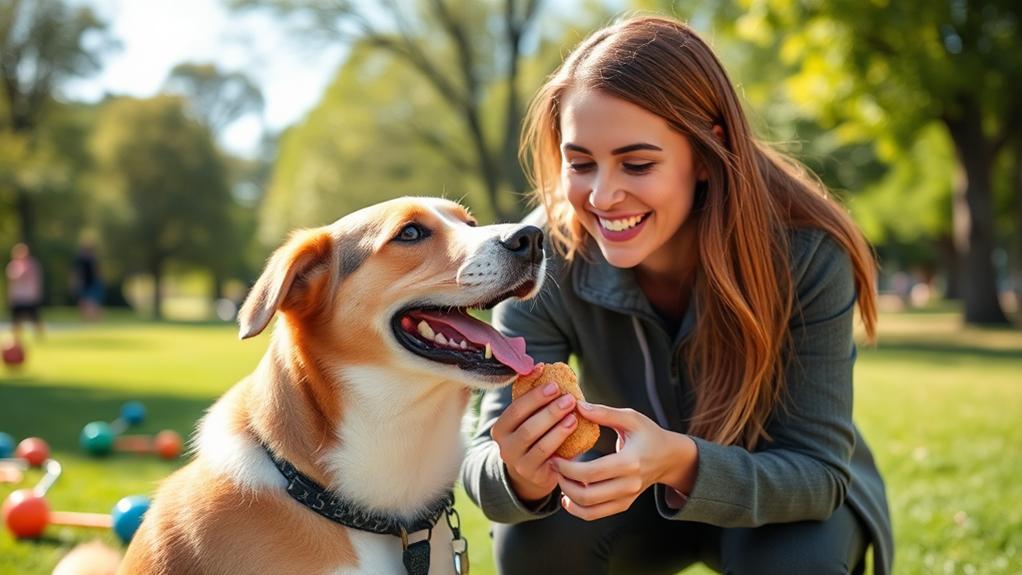Positive reinforcement in dog training revolves around rewarding good behavior to strengthen your bond with your dog. You'll want to identify what motivates your pup, whether it's treats, toys, or praise, and reward them immediately after they perform the desired action. Consistency is key; use the same commands and regularly practice in short sessions. Remember to celebrate small successes to build confidence. This method not only makes training enjoyable but also fosters trust and reduces anxiety. If you're curious about refining your technique, there are additional strategies that might enhance your training experience further.
Understanding Positive Reinforcement
When you understand positive reinforcement, you'll realize it's one of the most effective ways to train your dog. This method focuses on rewarding your dog for desired behaviors, which encourages them to repeat those actions. Instead of punishing unwanted behaviors, you redirect your dog's energy towards what you want them to do, creating a positive training environment.
To implement positive reinforcement, identify what motivates your dog—this could be treats, toys, or praise. When your dog performs a desired action, immediately reward them to reinforce the behavior. The timing of your reward is important; it should happen right after the behavior to create a clear connection.
It's also necessary to be consistent. Use the same commands and rewards each time, ensuring your dog understands what's expected. Start with simple behaviors, like sitting or staying, and gradually increase the complexity as your dog learns. Remember, patience is critical. Dogs learn at their own pace, and celebrating small victories along the way makes training enjoyable for both of you. By fostering a positive experience, you're not just teaching your dog; you're building a stronger bond based on trust and understanding.
Benefits for Dog Training

Positive reinforcement not only helps your dog learn desired behaviors but also offers numerous benefits for both you and your pet. By using this method, you create a positive learning environment that strengthens your bond.
- Stronger Bond: Using treats and praise fosters trust and connection between you and your dog.
- Increased Motivation: Your dog becomes more enthusiastic to learn and perform, knowing they'll receive rewards for good behavior.
- Reduced Fear and Anxiety: Positive reinforcement helps create a stress-free training atmosphere, making your dog feel safe and secure.
- Better Behavior Retention: Dogs trained with positive reinforcement are more likely to remember desired behaviors long-term, as they associate them with enjoyable experiences.
- Greater Training Enjoyment: You'll find training sessions more fun and fulfilling, which encourages consistency and commitment in your training routine.
Incorporating positive reinforcement into your training not only enhances your dog's skills but also leads to a happy, well-adjusted pet. You'll both enjoy the process, making it a rewarding journey toward a well-behaved canine companion.
Timing of Rewards
Effective timing of rewards plays an essential role in successful dog training. When you reward your dog immediately after they perform a desired behavior, it helps them connect the action with the reward. This connection reinforces the behavior, making it more likely to be repeated in the future. If you wait too long to deliver the reward, your dog may not associate the treat or praise with the specific action you want to encourage.
To achieve effective timing, try to reward your dog within a few seconds of the desired behavior. For instance, if your dog sits on command, give them a treat as soon as their bottom touches the ground. This clarity in timing helps your dog understand exactly what they did right.
It's also important to stay consistent. If you reward your dog for sitting one time and not the next, it can confuse them. Keeping a consistent reward schedule strengthens their learning. Remember, your enthusiasm matters too! A positive tone and excited body language can enhance the effectiveness of your timing, making the experience enjoyable for your dog. When you master timing, you'll see significant improvements in your dog's training progress.
Types of Rewards

While various rewards can motivate your dog, understanding the types that resonate most with them is indispensable for effective training. Different dogs respond to different types of rewards, so it's pivotal to experiment and find what works best for your furry friend.
- Treats: High-value treats, like small pieces of chicken or cheese, often grab your dog's attention and can be used for training sessions.
- Toys: Some dogs are motivated by play. A favorite toy can serve as a great reward for good behavior.
- Praise: Verbal praise and a happy tone can be incredibly motivating. Your dog loves hearing you acknowledge their good behavior.
- Affection: Physical touch, such as petting or belly rubs, can reinforce positive behavior and strengthen your bond.
- Freedom: Allowing your dog a bit of freedom, like a short leash walk after a successful training session, can be an enticing reward.
Shaping Desired Behaviors

Shaping desired behaviors in your dog involves breaking down complex actions into manageable steps, making it easier for them to learn. Start by identifying the behavior you want to teach. For example, if you want your dog to roll over, begin with the basic action of lying down.
Next, reward your dog each time they perform a behavior that moves towards your goal. If they lie down, give them a treat. If they turn onto their side, reward that too. This gradual approach helps your dog comprehend what you're looking for without feeling overwhelmed.
Use a clicker or verbal cue to mark the exact moment they perform the desired action, reinforcing their learning. Be patient; this process can take time. If your dog seems confused, go back a step and guarantee they're comfortable before progressing.
Always remember to keep training sessions short and fun to maintain your dog's interest. By celebrating small successes along the way, you'll build your dog's confidence and motivation. With persistence and positive reinforcement, your dog will learn the desired behavior while enjoying the training experience.
Consistency in Training

Training your dog requires a consistent approach to reinforce the behaviors you want to encourage. Consistency helps your dog understand what's expected and builds a solid foundation for learning. If you're inconsistent, your dog may get confused, making training less effective.
Here are some key points to maintain consistency in your training:
- Use the same commands: Stick to specific words for commands. For example, always use "sit" instead of varying it with "sit down."
- Reward immediately: Provide rewards right after your dog performs the desired behavior. This helps them make a connection between the action and the reward.
- Set clear rules: Establish and communicate rules that your dog must follow. Make sure everyone in your household is on the same page.
- Practice regularly: Frequent training sessions reinforce learning. Short, daily sessions are often more effective than longer, sporadic ones.
- Be patient: Understand that consistency takes time. Stay calm and focused, and don't rush the process.
Building a Trusting Relationship

Building a trusting relationship with your dog is essential for effective training. When your dog trusts you, it's more likely to respond positively to commands and cues. Start by spending quality time with your dog, engaging in activities that you both enjoy. This helps strengthen your bond and builds a solid foundation for training.
Use positive reinforcement consistently to encourage desirable behaviors. Reward your dog with treats, praise, or playtime when it accomplishes a task. This not only reinforces good behavior but also shows your dog that you're a reliable source of positivity and support.
Be patient. Trust takes time to develop, and every dog learns at its own pace. Avoid using harsh corrections or negative reinforcement, as these can damage your relationship and lead to fear or anxiety. Instead, focus on maintaining a calm and supportive environment.
Lastly, pay attention to your dog's body language. Understanding its signals will help you respond appropriately, reinforcing your bond and making training more effective. Remember, a trusting relationship fosters a cooperative spirit, making your training sessions enjoyable for both you and your furry friend.
Common Misconceptions

When it comes to dog training, many misconceptions can hinder your progress and understanding. These myths can lead to confusion and frustration, making it harder for you to effectively train your dog using positive reinforcement methods. Let's clear up some of these common misconceptions:
- Positive reinforcement means spoiling your dog. It's about rewarding desired behaviors, not giving in to demands.
- You can only use treats for reinforcement. While treats are effective, praise, toys, and playtime can also serve as powerful rewards.
- Training should be quick and easy. Building lasting behavior takes time, patience, and consistency.
- Once a dog learns a command, it won't forget it. Dogs need regular practice to maintain their skills and knowledge.
- Positive reinforcement is only for puppies. Dogs of all ages can benefit from positive reinforcement techniques.
Understanding these misconceptions helps you approach training with a clear mindset. Focus on building a positive relationship with your dog, and remember that patience and consistency are key elements in successful training. With the right approach, you'll see progress and strengthen your bond with your furry friend.
Challenges and Solutions

Misconceptions can make dog training feel overwhelming, especially when you encounter common challenges along the way. One major challenge is inconsistency. If you don't reward your dog consistently, they may not understand what behavior you're reinforcing. To tackle this, create a clear training schedule and stick to it. Use the same cues and rewards each time to help your dog learn more effectively.
Another issue is distractions during training. Dogs are curious creatures, and outside stimuli can easily divert their attention. To overcome this, start training in a quiet environment and gradually introduce distractions as your dog becomes more focused.
You might also face frustration if your dog doesn't seem to respond as quickly as you'd like. Remember, every dog learns at their own pace. Patience is key! Break tasks into smaller steps and celebrate small victories along the way.
Lastly, avoid over-rewarding. While treats are effective, too many can lead to weight gain. Use a variety of rewards, including praise and playtime, to keep your dog motivated without relying solely on treats. With these strategies, you'll find solutions to the challenges of positive reinforcement training.
Long-term Maintenance of Training

Maintaining your dog's training over the long term requires consistent effort and engagement. It is critical to remember that training isn't a one-time event; it's an ongoing process. Here are some key strategies to guarantee your dog retains their training:
- Regular Practice: Incorporate short training sessions into your daily routine. Frequent, brief sessions are more effective than infrequent, lengthy ones.
- Variety in Rewards: Keep your dog motivated by varying the types of rewards. Use treats, praise, and playtime to maintain interest.
- Generalization: Practice commands in different environments and situations. This helps your dog understand that training applies everywhere, not just in familiar settings.
- Consistency: Ensure everyone in your household uses the same commands and rewards. Consistency prevents confusion and reinforces learning.
- Ongoing Learning: Consider enrolling in advanced classes or engaging in new activities. This keeps training fun and stimulating for both you and your dog.
Conclusion
Incorporating positive reinforcement in your dog training not only helps shape desired behaviors but also strengthens the bond between you and your furry friend. By understanding the timing and types of rewards, you can make training a fun and rewarding experience for both of you. Remember, patience is key—challenges may arise, but with persistence, you'll see long-term success. Embrace these principles, and watch your dog thrive while enjoying the journey together!



